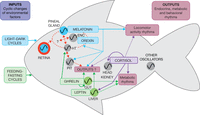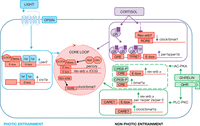Interplay between the endocrine and circadian systems in fishes
-
Figure 1
The fish circadian system: a net of circadian oscillators. The fish circadian system is composed of a net of oscillators that are widely distributed throughout the entire organism. These oscillators are entrained by external inputs, such as the light–darkness and feeding–fasting cycles and should be linked to generate outputs (such as locomotor activity and metabolic rhythms) in a coordinated manner. The retina, pineal gland and probably some deep brain photoreceptors are directly targeted by light, which then entrains the endogenous clocks in such structures (shown in blue). Other organs that contain circadian clocks, such as the gut and liver, are probably targeted by any feeding- or metabolic-related signals, which mainly synchronise these oscillators to the energetic status of the animal (shown in green). The head kidney is probably entrained by both external signals (shown in purple). These endocrine organs (pineal gland, pituitary gland, gut, liver and head kidney) release hormones (melatonin, pituitary hormones, ghrelin, leptin and cortisol) in a time-dependent pattern, which may provide a temporal message to specific-hormone receptors. This diagram only shows the most studied endocrine organs that are functionally related to the circadian system; however, other oscillators also probably exist. The continuous lines indicate the connections that are currently known to exist in fishes, whereas the dashed lines illustrate hypothetical connections that have not yet been reported. ENC, other encephalic nuclei; HT, hypothalamus; PIT, pituitary gland. For more information, see the text.
-
Figure 2
Hypothetical model of entrainment of circadian oscillators by light and hormonal inputs in fishes: putative mechanisms for the synchronisation of endogenous clocks. The molecular core of the endogenous oscillators is thought to be synchronised by exogenous (light) or endogenous (hormones) temporal messengers through the induction or repression of specific clock genes (for more information, see the text). Events that occur in the cytoplasm and nuclei (gene transcription) have not been separated to simplify the figure. In each box, only putative response elements that are involved in each response (light, cortisol or ghrelin) are shown. The molecular core of the clock, i.e. the feedback loops that sustain the 24-h clock gene oscillations, is represented as the central circle in red, with some of the main elements inside. This molecular mechanism can be entrained by the light–darkness cycle via the light-evoked induction of cry1 and per2, which involves functional E- and D-boxes and the Tef transcription factor in zebrafish (Tamai et al. 2007, Vatine et al. 2009, 2011). We also propose alternative mechanisms whereby hormones such as cortisol and ghrelin can entrain the molecular clocks. Cortisol induces per1a and per1b, while repressing bmal1a and clock in the goldfish liver, with this repression possibly being mediated by the Rev-erb transcription factor (Sánchez-Bretaño 2016). Ghrelin induces a variety of clock genes in the goldfish liver (Sánchez-Bretaño A, Blanco AM, Alonso-Gómez AL, Delgado MJ, Kah O & Isorna E, unpublished observations), which is mainly mediated by the PLC-PKC pathway and, to a lesser extent, the AC-PKA pathway (Sánchez-Bretaño 2016). AC-PKA, adenylyl cyclase-protein kinase A; CARE, calcium response element; CCG, clock-controlled genes; CRE, CREB response element; CREB-P, CREB phosphorylated; GHR, ghrelin receptor; GR, glucocorticoid receptor; GRE, glucocorticoid response element; PLC-PKC, phospholipase C-protein kinase C; RORE, RAR-related orphan receptor response element; Tef, thyrotroph embryonic factor; TF, transcription factor; TFRE, transcription factor response element.
- © 2017 Society for Endocrinology













